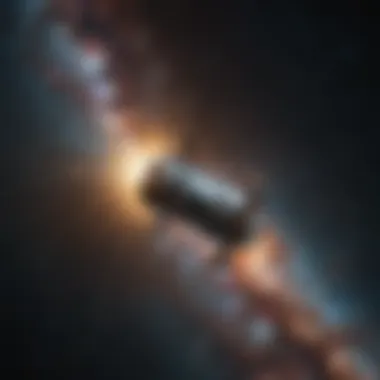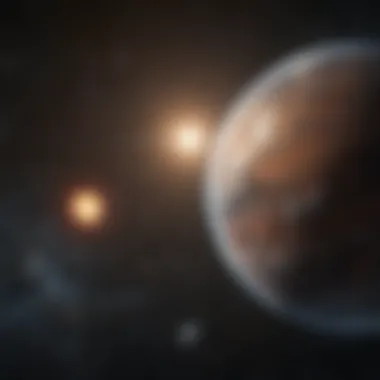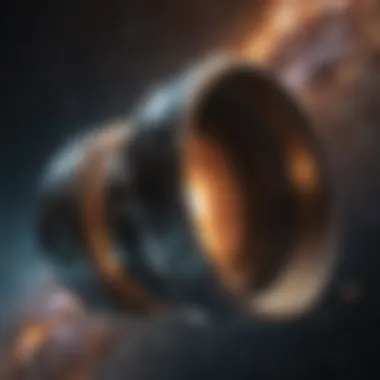The Hubble Space Telescope: Current Status and Location


Intro
The Hubble Space Telescope has served as a pivotal instrument in the field of astronomy for over three decades. Launched on April 24, 1990, this remarkable observatory has provided scientists with unprecedented insights into the universe. As we examine its current location and operational status, it becomes essential to understand the ongoing contributions of Hubble and its implications for future research.
This article delves into Hubble's recent findings which have significantly enhanced our understanding of cosmic phenomena. Through an exploration of its operational status, we aim to highlight the telescope's enduring legacy as it continues to aid scientists across the globe.
Key Research Findings
Overview of Recent Discoveries
Hubble’s innovative design and technology have allowed it to capture breathtaking images and collect valuable data. Recent discoveries include exoplanets in distant solar systems and detailed observations of star formation in galaxies. Such research contributes to the broader understanding of how galaxies evolve and the potential for life beyond Earth.
Researchers have also utilized Hubble to measure the expansion rate of the universe more accurately, a task critical for understanding cosmic dynamics. Findings indicate discrepancies in the rate of expansion, prompting further investigation into previously unexplored areas of astrophysics. This has significant implications for theories surrounding dark matter and dark energy, two of the most enigmatic elements in our universe.
Significance of Findings in the Field
Hubble’s contributions to astronomy extend beyond mere observations. The data collected has helped refine existing theories and even challenge long-held assumptions about the universe. By revealing new phenomena, such as cosmic inflation and gravitational lensing, Hubble plays a vital role in shaping contemporary astrophysical models.
Moreover, its findings have inspired the next generation of space observatories that aim to deepen our understanding even further. As we continue to unravel the complexities of the universe, Hubble's legacy stands as a testament to human curiosity and technological advancement.
"Hubble has not only expanded our knowledge but also ignited our imaginations about the universe."
Looking Forward: Future Missions and Continued Relevance
As the scientific community looks to the future, Hubble's role is underlined by ongoing missions and potential successor projects. Plans for the James Webb Space Telescope, for instance, are expected to enhance capabilities initially delivered by Hubble while uncovering new cosmic insights.
Hubble is not merely a historical artifact but an active participant in the ongoing quest for knowledge. Its continued relevance is assured through collaborative efforts among various research institutions, ensuring that the legacy of discovery marches forward.
The End
The Hubble Space Telescope remains a cornerstone of modern astrophysics. Its current operational status exemplifies the extraordinary capabilities of space-based observatories. Through continual findings, it enriches our comprehension of cosmic intricacies and shapes future research, establishing an enduring legacy that continues to influence the scientific community.
As we reflect on Hubble's contributions, we are reminded of the importance that such instruments hold in bridging the gap between knowledge and discovery, propelling humanity into a future filled with aspirations beyond the stars.
Prolusion to the Hubble Space Telescope
The Hubble Space Telescope is a pivotal instrument in the realm of astronomy and astrophysics. It has transformed our understanding of the universe since its launch in 1990. This section provides an essential foundation for comprehending Hubble's significance, its historical development, and its ongoing contributions to scientific exploration. Understanding the Hubble Space Telescope is not only about acknowledging its scientific achievements but also recognizing how it has influenced our perspective on cosmic phenomena.
Brief History of Hubble
The conception of the Hubble Space Telescope dates back to the 1940s, with a community of scientists advocating for an observatory beyond Earth’s atmosphere. This idea gained significant traction in the 1970s, largely due to the work done during the Apollo missions. The telescope itself was named after the renowned astronomer Edwin Hubble, who played a crucial role in establishing the expanding universe theory. Construction began in the 1970s, culminating in its launch aboard the Space Shuttle Discovery on April 24, 1990. Hubble's initial years faced challenges, most notably an optical flaw in its primary mirror which required a servicing mission. Despite these hurdles, subsequent servicing missions enabled the installation of advanced instruments, augmenting its capabilities and ensuring its position as a leading astronomical tool.
Launch and Deployment
Hubble was deployed into Low Earth Orbit at an altitude of approximately 547 kilometers, allowing it an unobstructed view of the universe. This deployment marked a new era in observational astronomy. The launch of Hubble involved intricate planning and coordination among multiple NASA divisions and contractors. After its deployment, the telescope began transmitting valuable data back to Earth.
Hubble's initial scientific findings were impressive. Early observations revealed insights into gamma-ray bursts and the age of clusters of galaxies. Over the years, its ability to capture images free from atmospheric distortion led to numerous groundbreaking discoveries, reshaping our understanding of phenomena like black holes and the rate of expansion of the universe. Today, Hubble continues to operate, providing vital insights into both our own solar system and distant galaxies.
Current Location of the Hubble Space Telescope
The current location of the Hubble Space Telescope is critical to understanding its capabilities and contributions to astrophysics. Hubble orbits Earth at an altitude of about 547 kilometers (approximately 340 miles). This positioning allows it to operate above the distorting effects of Earth's atmosphere, leading to clearer and more precise observations of celestial objects. This positioning plays a major role in its operational effectiveness, enabling a variety of scientific missions aimed at exploring the universe.
Orbit and Positioning


Hubble's orbit is classified as a low Earth orbit. This specific orbit enables the telescope to complete a full revolution around Earth roughly every 95 minutes. Due to this speed, Hubble experiences a significant number of sunrises and sunsets each day, alternating its exposure between sunlight and the cooler darkness of space. The stability of its orbit is crucial, as small adjustments are periodically necessary to maintain its trajectory and performance. These adjustments occur through onboard thrusters that counteract the natural drag from residual atmosphere at this altitude.
The telescope's inclination is about 28.5 degrees to the equator, allowing it to observe a wide swath of the sky from its vantage point. Unlike geostationary telescopes that remain fixed over a specific point, Hubble's orbit permits a broader view, accommodating various astronomical phenomena, including distant galaxies, nebulae, and exoplanets.
Spatial Relationship with Earth
The spatial relationship of Hubble with Earth enhances its operational efficiency and scientific return. Being closer to Earth than many other telescopes, it facilitates maintenance missions conducted by astronauts. NASA has performed five servicing missions since its launch, allowing upgrades to instruments and the replacement of essential components. This unique characteristic of Hubble's orbit underscores its ongoing viability in the fast-paced world of astronomical research.
The ability to communicate effectively with ground control is also influenced by Hubble's spatial position. Data transmission occurs through multiple ground stations, offering a robust link back to Earth for real-time analysis and command execution.
Hubble’s orbit minimizes atmospheric interference, ensuring clarity and precision in its observations, which are vital for groundbreaking discoveries.
In summary, Hubble's current location and its designed orbit are fundamental to its mission. This unique positioning allows the telescope to perform groundbreaking observations while remaining accessible for advancements. Hubble continues to challenge our understanding of the cosmos, establishing its significance in modern astronomy.
Operational Status of Hubble
The operational status of the Hubble Space Telescope is a critical topic discussed in this article. This subject not only reflects how well the telescope functions but also emphasizes its relevance in ongoing astronomical research. Understanding Hubble’s operational capacity gives insight into what discoveries are being made or are still possible. Its longevity and the continuous improvements speak volumes about its technological robustness and the commitment of the scientific community to keep it at the forefront of innovation.
Recent Instrument Upgrades
Hubble has undergone several significant upgrades that enhanced its operational capabilities. The most recent of these upgrades was carried out during the servicing missions, which allowed for modernization of instruments. For instance, the Wide Field Camera 3 was installed in 2009. This instrument vastly increased the telescope's capacity for capturing detailed images, enabling astronomers to observe distant galaxies in deeper detail than ever before.
Further, upgrades to other systems, such as the Cosmic Origins Spectrograph and the Advanced Camera for Surveys, expanded the range of wavelengths Hubble could study. These improvements contribute to Hubble's ability to explore new areas of research, from the early universe to the composition of exoplanet atmospheres.
Mission Performance Metrics
Analyzing the mission performance metrics of Hubble is essential for assessing its current status. Hubble has exceeded initial expectations, with a mission life originally projected at only fifteen years. Now, it has been in operation for over three decades.
Key performance indicators for Hubble include:
- Observation Time: Hubble allocates its time for observations across numerous scientific projects, with many peer-reviewed proposals submitted annually.
- Data Output: The telescope has delivered vast amounts of data to the global astronomical community, facilitating thousands of research papers and studies.
- Success Rate: Upward of 80% of Hubble observations align with successful data collection and publication, underscoring its reliability as a scientific instrument.
Scientific Contributions
The Hubble Space Telescope has significantly influenced the field of astronomy since its launch. Its contributions cannot be overstated; they have reshaped our understanding of the universe. The data gathered through Hubble's observations have led to critical advancements in various domains of astrophysics and cosmology. These discoveries enhance not only scientific knowledge but also public interest in space exploration.
Major Discoveries
Hubble has played a pivotal role in numerous astronomical breakthroughs. Some of these discoveries include:
- Expansion of the Universe: Hubble's observations of distant galaxies showed that they are moving away from us. This led to the understanding that the universe is expanding, a foundation for modern cosmology.
- Dark Energy: The telescope contributed to the discovery of dark energy, a mysterious force impacting the acceleration of the universe's expansion. Understanding dark energy is crucial for future cosmic theories.
- Exoplanets: It provided invaluable data regarding atmospheres of distant exoplanets, enhancing our grasp of planetary systems beyond our own.
The insights gained from these domains have driven further research, showcasing how pivotal Hubble has been.
Impact on Astronomy
Hubble's impact extends beyond mere discoveries; it has revolutionized methodologies within the field. Its ability to observe in ultraviolet, visible, and near-infrared light allows astronomers to investigate celestial phenomena with unprecedented clarity. This has led to:
- Improved Models: Hubble's findings have refined existing astronomical models, facilitating a deeper understanding of the lifecycle of stars and galaxies.
- Inspiration for Future Missions: The successful methods utilized by Hubble have laid groundwork for future observatories, such as the James Webb Space Telescope, thus pushing the boundaries of what we can explore in space.
- Increased Collaboration: Hubble's data has fostered cooperation among global research communities, leading to joint projects and shared findings.
Hubble's contributions have not only been instrumental in expanding scientific knowledge but also in cultivating a communal spirit in astronomical research.
In summary, the scientific contributions of the Hubble Space Telescope are immense. Its discoveries reshape our understanding of fundamental cosmic questions and inspire future explorations.
Hubble's Role in Contemporary Research


The Hubble Space Telescope plays a vital part in modern astronomical research, acting as a cornerstone for various scientific inquiries. Its capabilities extend beyond simple observation, facilitating collaborative efforts with other missions and enabling groundbreaking studies. This multifaceted role emphasizes Hubble's significance in pushing the boundaries of knowledge in the field of astronomy.
Collaboration with Other Missions
Hubble often works in tandem with other space missions and observatories. This collaboration enhances the depth of research and provides richer datasets for analysis. For example, Hubble has partnered with the Chandra X-ray Observatory, which specializes in X-ray astronomy. Together, they create a comprehensive view of celestial objects by combining visible light data from Hubble and X-ray data from Chandra.
Additionally, Hubble's collaboration with the James Webb Space Telescope has been extensively discussed, and such partnerships are designed to maximize the advantages of both telescopes. Each telescope has its strengths; Hubble’s visible and ultraviolet observations complement Webb’s infrared capabilities, creating a synergy that leads to new discoveries.
Enlist collaborations provide insights into extreme cosmic events or phenomena, helping astronomers understand black holes' behavior, distant galaxies, or the formation of stars. The results from these joint efforts are frequently published in prominent journals, elevating the research’s overall impact and reaching a broader audience.
Examples of Recent Studies
Recent studies facilitated by Hubble illustrate its ongoing relevance in contemporary astronomy. One notable study involved tracking the movement of a comet as it passed near Jupiter, providing critical data about its path through the solar system. Researchers utilized Hubble's precise imaging capabilities to capture detailed images of the comet, enhancing our understanding of its composition and trajectory.
Another significant effort involved observing the mysteries of dark matter. By studying the light bending around galaxy clusters, astronomers gained insights into the distribution of dark matter in the universe. Hubble's advanced technology allowed detailed observations that would have otherwise been impossible from ground-based telescopes.
In the field of exoplanet research, Hubble has also played an essential role. For instance, it has analyzed the atmospheres of distant planets, revealing the presence of key molecules like water vapor. This work not only contributes to our understanding of potentially habitable worlds but also informs future missions that aim to discover Earth-like planets in other star systems.
Hubble's ongoing contributions to astrophysical phenomena drive forward our understanding of the universe, proving invaluable for both current and future generations.
Future Outlook for Hubble
The future of the Hubble Space Telescope holds critical significance not just for ongoing astrophysical studies, but also for understanding the trajectory of space exploration as a whole. As one of the most productive scientific instruments, Hubble has reshaped our knowledge of the universe. Therefore, examining its future outlook encompasses multiple factors, including anticipated operational capabilities and upcoming technologies designed to carry forward its legacy.
Expected Lifespan and Operations
Hubble was launched in 1990, with an expected mission lifespan of about 15 years. However, due to various upgrades and repairs conducted by NASA astronauts, Hubble has far exceeded these expectations. As of now, Hubble is projected to continue its operations into the late 2020s, contingent upon the functionality of its scientific instruments and support systems.
The telescope operates in low Earth orbit at an altitude of approximately 547 kilometers. Maintaining its operations requires ongoing monitoring and occasional adjustments from ground control. These operations ensure that Hubble remains stable and aligned properly for its observations. Regular assessments of system health are necessary, as Hubble relies on a range of backup systems. Any major malfunctions could shorten its operational period significantly.
Key factors influencing Hubble’s operational lifespan include:
- The integrity of its onboard instruments
- The status of its gyroscopes, which maintain its orientation
- The efficiencies of its power systems
While repair missions are no longer feasible, the resilience demonstrated thus far suggests the telescope could remain functional well beyond its expected demise. As Hubble continues to unveil the mysteries of the cosmos, understanding these operational constraints is essential for capitalizing on its scientific contributions.
Potential Successor Technologies
While Hubble remains uncompromised in its function, discussions surrounding its successor technologies are already underway. The James Webb Space Telescope (JWST) is perhaps the most notable future project aimed to complement—if not replace—Hubble’s unique observational capabilities. Scheduled to be fully operational, JWST will provide unprecedented infrared observation capabilities, allowing astronomers to peer further back in time compared to Hubble's optical focus.
Also, other emerging technologies, like the Wide Field Infrared Survey Telescope (WFIRST), broaden the scope of astronomical research possibilities. WFIRST is being developed to study dark energy and other cosmic phenomena, showcasing a clear intention of pushing beyond the methods that Hubble established.
Potential technologies that might influence future exploratory missions include:
- Advanced adaptive optics
- Next-generation spectrographs
- Increased onboard data processing capabilities
Public Engagement and Outreach
Public engagement and outreach are essential components of the Hubble Space Telescope's mission. The significance lies not only in communicating scientific findings but also in fostering a connection between the public and the wonders of the universe. Understanding the importance of outreach activities can highlight the broader role of such missions in society and education. It provides an avenue for people to engage with complex scientific ideas in an accessible manner, increasing knowledge and inspiring future generations in scientific fields.
Educational Programs Related to Hubble
Educational programs related to the Hubble Space Telescope are crucial for disseminating knowledge and fostering interest in astronomy. These initiatives cater to different demographics, including students, teachers, and the general public. For example, the HubbleSite offers numerous educational resources, including lesson plans, interactive activities, and audiovisual materials that help explain basic astronomical concepts. Utilization of Hubble images in classrooms through specific programs leads to an enhanced understanding of space.


Some distinct features of these programs include:
- Workshops and Seminars: These often target educators, providing them with tools to teach astronomy effectively.
- Collaborations with Schools: Hubble often teams up with educational institutions to develop tailored content.
- Online Resources: Students can access a plethora of online materials that include interactive simulations and quizzes to reinforce their knowledge.
This multidimensional approach strengthens public understanding of science and promotes critical thinking skills, vital for a scientifically literate society.
Media Coverage and Public Interest
Media coverage plays a pivotal role in shaping public interest in the Hubble Space Telescope. The media often highlight groundbreaking discoveries and stunning images from Hubble to captivate the audience’s imagination. Notable examples include coverage of Hubble’s deep field images and its observations of distant galaxies. This kind of exposure helps connect complex scientific advancements to everyday life.
Moreover, various platforms, including social media, have made it easier for the public to access space-related content. Regular updates by NASA and organizations like the European Space Agency engage audiences through photographs and interesting facts.
The implications of sustained media coverage include:
- Increased Public Awareness: Regular discussions about Hubble’s findings spark curiosity in astronomy.
- Support for Science Funding: As interest grows, so does the likelihood of continued funding for scientific endeavors.
Overall, the fusion of educational programs and robust media coverage serves to amplify the significance of the Hubble Space Telescope in contemporary society, encouraging a lifelong interest in space and science.
Challenges Facing the Hubble Space Telescope
The Hubble Space Telescope stands as a monumental achievement in the field of astronomy. Yet, it does not operate in an environment free from challenges. Understanding the difficulties faced by this telescope is crucial for grasping its current operational capabilities and future outlook. The challenges can be broadly categorized into technical and environmental risks alongside issues of funding and resource allocation. Each of these elements plays a significant role in how Hubble performs and how it contributes to scientific research.
Technical and Environmental Risks
Hubble's location in low Earth orbit exposes it to various technical and environmental risks. These risks include:
- Radiation Exposure: The telescope operates in an environment filled with cosmic radiation. This radiation can affect the sensitive electronic instrumentation onboard Hubble, potentially leading to malfunctions or degradation over time.
- Micro-Meteorite Impacts: While Hubble has protective shielding, it remains vulnerable to impacts from micro-meteorites. Even small particles traveling at high speeds can cause significant damage, requiring ongoing assessments and repairs.
- Orbital Decay: Over the years, Hubble has faced the inevitable slow decrease in its orbit. Atmospheric drag causes its altitude to reduce slightly each year, putting pressure on its operational longevity and necessitating considerations for potential reboost missions or other measures to maintain its position.
In summary, technical issues and environmental factors pose consistent threats to the Hubble Space Telescope. Addressing these risks is essential to ensure Hubble can remain functional and continue to provide valuable scientific insights.
Funding and Resource Allocation
The sustenance of Hubble’s operations hinges on adequate funding and effective resource allocation. Financial resources are crucial for:
- Ongoing Maintenance: Periodic servicing missions, like those that took place in the 1990s and early 2000s, were critical to upgrading Hubble’s instruments. These missions were costly and drew heavily on NASA’s budget.
- Scientific Research Grants: Researchers planning to use Hubble’s capabilities must often compete for grants. The availability of such funding directly impacts the number and quality of scientific projects that can be undertaken.
- Technological Updates: As technology rapidly evolves, updating Hubble's systems to incorporate new tools is necessary. However, these upgrades require significant financial and human resources, and funding decisions can be politically influenced, complicating efforts to secure necessary support.
Hubble's capacity to continue functioning optimally largely depends on the allocation of sufficient funding. Without it, the telescope risks falling behind in an ever-advancing field of space exploration.
End
The discussion surrounding the Hubble Space Telescope is crucial in understanding its lasting impact on astronomy and astrophysics. This telescope has not only broadened our view of the universe but also refined our observational techniques, enabling astronomers to study celestial bodies with unprecedented clarity. By summing up Hubble's significant contributions, we can better appreciate how it has reshaped scientific inquiry and public awareness of space.
Summarizing Hubble’s Impact
Hubble's revolution in space observation has been marked by several key achievements. Its stunning images and accurate data have led to major discoveries, including the expansion rate of the universe and the identification of exoplanets. These revelations have had far-reaching implications.
The advancements in technology that Hubble introduced paved the way for future missions. Hubble acted as a precursor, demonstrating the value of space-based observatories. It has stimulated interest in astronomy at both the amateur and professional levels and fostered numerous collaborations among research institutions worldwide.
Certain elements that summarize Hubble's impact include:
- Discovery of Dark Energy: Hubble played a fundamental role in establishing the notion of dark energy, profoundly altering our comprehension of the universe.
- High-Resolution Imaging: The telescope has provided detailed imagery of galaxies, nebulae, and star clusters, enhancing our knowledge of their formation and evolution.
- Public Engagement: The breathtaking visuals captured by Hubble have engaged the public, raising awareness about the universe and its mysteries.
The Future of Space Observatories
Looking ahead, the future of space observatories builds on the legacy left by Hubble. New technologies and innovations are set to expand upon Hubble's findings, promising a deeper understanding of the cosmos. Future projects, such as the James Webb Space Telescope, aim to complement Hubble's work by examining the universe's vast regions at longer wavelengths, revealing phenomena that Hubble's instruments cannot.
Key considerations for the future of space observatories include:
- Advanced Instruments: Development of more sensitive detectors and broader spectral range capabilities will enhance our ability to observe previously hidden aspects of the universe.
- Collaboration: Increased international partnership among space agencies will be essential to share knowledge and resources, ensuring that future missions can succeed.
- Long-term Sustainability: Attention to funding and resource allocation will play a critical role in sustaining these ambitious projects over time.
As we reflect on the position of the Hubble Space Telescope, its impact remains as significant as ever, paving the way for the next generation of astronomical exploration.















